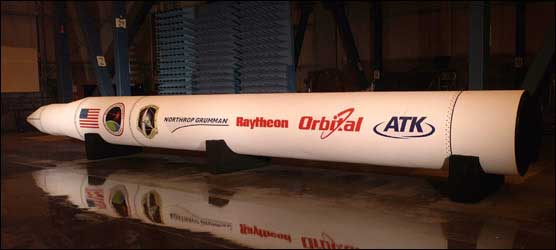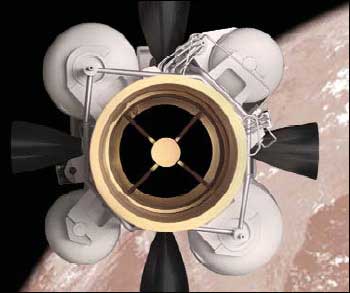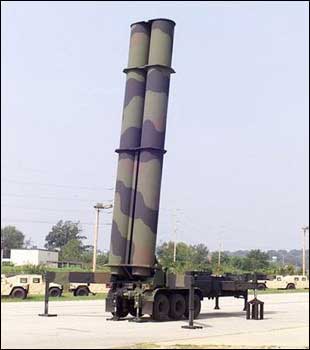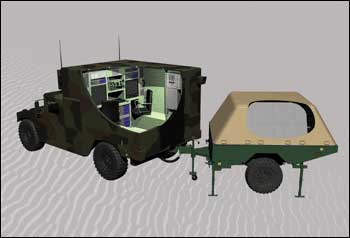|
With the threat of enemy missile attacks on the
U.S. and our allies ever present, the need for interception
capabilities grows. To that end, the Pentagon's Ballistic
Missile Defense System has a new star player: The Kinetic
Energy Interceptor.

Killer Features:
- Ground based launcher is mobile (truck
transportable)
- Italy-based launcher could shield
Western Europe; Virginia based launcher could defend
Atlantic coast
- Top speed will be in excess of 12,000
mph
- Can be submarine launched from modified
Ohio-class SSBN submarines
The mandate of the Missile Defense
Agency (MDA) is simple: Protect America and her allies
from the threat of Theater and Intercontinental Ballistic
Missiles. Getting the job done, on the other hand, is
not quite that easy, especially in an age where enemy
missiles could be launched from conceivably anywhere.
To provide as much coverage as possible, in addition
to developing high energy systems such as the Airborne
Laser (ABL), the MDA is researching a number of ground
and sea-based approaches, one of which is a direct attack
kinetic energy interceptor (KEI). This projectile has
one purpose: Track incoming missile threats, and destroy
them with a non-explosive kinetic energy warhead.
A View to a Kill
The KEI system, as being developed by
Northrop Grumman and Raytheon on a joint contract, features
a mobile land-based launcher built by Northrop Grumman
and subcontractor SEI; a Raytheon-built interceptor
that will be faster and more agile than any other interceptor
to date; a HMMWV that will house the command and control
battle management and communications system; and satellite
receivers to process the signal that a hostile missile
has been launched. The equipment is highly mobile and
can be easily loaded onto a C-17 aircraft and transported
worldwide.
At approximately 12 meters long and
1 meter wide, the KEI interceptor is twice the size
the RIM-161A Standard Missile-3 (SM-3), which currently
provides allied forces and U.S. protection from short
to intermediate range ballistic missiles. The KEI attacks
its targets at a maximum speed of 12,000 mph, more than
twice the speed of the SM-3. Its premise is logical:
destroy enemy missiles in their most vulnerable stage
-- the "boost" phase of flight, before reentry
vehicles, decoys or countermeasures can be deployed.
 |
| In
for the kill: The Exoatmospheric Kill Vehicle within
the KEI projectile seeks out and demolishes enemy
missiles. |
When a threat has been detected, the
KEI projectile is launched toward its target. The first
and second stages of the booster will burn together
in 60 seconds, giving the projectile a speed of 6 kilometers
per second. Finally, the projectile adjusts its trajectory
and ejects the Exoatmospheric Kill Vehicle, a device
that is used to destroy enemy missiles outside the atmosphere.
The Kill Vehicle uses an infrared seeker to detect and
discriminate the reentry vehicle from other objects.
Then the "hit-to-kill" concept is carried
out, as the Kill Vehicle collides with the incoming
warhead, completely pulverizing it.
Larger Engagement Area
The challenges involved in the KEI program
are manifold. In order to catch the missiles it is supposed
to destroy, the KEI needs to be fast -- really, really
fast. This is accomplished by making the KEI small and
light and packing it with solid rocket fuel. Unfortunately,
the tradeoff is that by doing so you limit the missile
to "boost" phase interceptions. For most theater
missiles, this is around 3 minutes (180 seconds), not
a very large launch window.
Due to this, the defending KEI battery
was initially intended to be stationed relatively close
to enemy threat launch platforms (500-1,500 km), which
would cut down on their effectiveness against missiles
launched from countries with large land masses, such
as Iran and China, or from blue-water launches from
open ocean. On the other hand, target missile tracking
during the boost phase is easier, since the missile
is accelerating linearly, and decoys, such as flares
and chaff bundles, would be less effective.
So it looked as KEI would be locked
down in its "boost phase" role, but conditions
change. But MDA's decision to build a highly flexible
kill vehicle for the KEI - which would be effective
in other phases of the missile defense regime - helped
convince agency officials that the missile could be
a capable performer in the ascent and mid-course phases
of a missile attack.
 |
| Photo
of the KEI Launcher. |
Upgrading the KEI to a "mid-course"
interceptor would enlarge the KEI's engagement window
considerably. During the mid-course phase, the threat
missile is no longer accelerating, and is arcing ballistically
through its apogee towards the target. This phase can
last as long as 1200 seconds, which would give an "assent"
or "mid-course" capable KEI 20 minutes to
engage the target.
It all adds up to a large engagement
area for the KEI. For example, a single battery of 10
missiles based in Italy could protect all of western
Europe against Middle East missile threats. One battery
based in Norfolk, Va., could protect the East Coast
of the United States from a launch 300 to 1,500 kilometers
off the coast. This is in opposition to KEI's critics,
who have stated that the weapon is essentially a one-country
missile intended to defend against an attack by North
Korea.
Challenges Ahead
One caveat to the "mid-course"
approach is that the missile would need to be significantly
larger than the current 12 meters long and 1 meter wide.
While this is not an issue for sub-launched, or ground-based
interceptors, the size makes their use aboard guided
missile cruisers and destroyers problematic (the largest
missile currently launched from the Ticonderoga cruisers
and Arleigh Burke destroyers is the SM-3 missile, which
is 6.5 meters long, and has a finspan of 1.5 meters.
 |
| KEI
Command Center: C2BMC Shelter with Interceptor Communication
Antenna. |
Another challenge facing the KEI is
actually hitting the target. While anti aircraft missile
interception technology has been around for some 40
years, the precision needed to intercept a ballistic
missile is significantly higher. The greatest challenge
in this equation is the data processing limitations
in the guidance system. With a closing speed as high
as 37,000 meters per hour (22,000 miles per hour), a
target missile can literally move hundreds of feet between
the computational cycles of the interceptor's course
correction software. As if that wasn't enough, the engagement
solution can be further complicated by the use of decoys,
such as flares and chaff, to spoof the KEI's sensors
and have it attack the wrong target.
"If it's an elaborate countermeasure,
then we will have to get more sophisticated," says
Larry Little, program director of the Missile Defense
Agency's KEI office. Getting around this problem could
be accomplished with smaller, terminally launched seeker
warheads, carried aloft by a booster, which would attack
all targets in the missile path, rather than try and
discriminate between target and decoy. Still another
option is to adopt a different tactic. "You don't
necessarily discriminate, you just shoot everything
that is up there," Little said.
Despite these challenges, a Northrop-Grumman/Raytheon
team is confident that they can meet the goals set by
the MDA. Granted $4 billion over the next 8 years, the
team is developing a "multi-window" KEI missile
using technology developed for the fielded SM-3 missile
interceptor. They are expected to have a prototype Ground
launched system ready for evaluation by 2010, with a
sea-based system ready by 2013. Initial elements of
the missile defense system, comprising two destroyers
armed with SM-3 air defense missiles, are to be deployed
in September. |